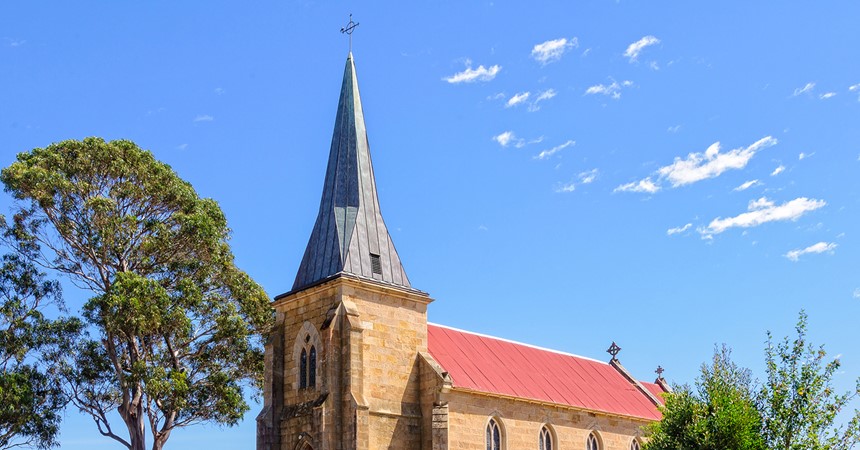History and architecture
The roots of St John’s Church can be traced back to Australia’s first Catholic Bishop, John Bede Polding OSB.
He visited Van Diemen’s Land, as Tasmania was known in 1835, and eventually arrived in Richmond. Bishop Polding pledged to erect a church on behalf of the local Catholics. A resident of the area, John Cassidy, gave land so the church could be built.
Polding's dream was to establish a Church founded on monastic ideals, in which scholarship and sublime liturgy, accompanied by Gregorian chant, would civilise and convert the new country, just as they had in earlier centuries in Europe.
But Polding's priests were mainly Irish, and this was not their idea of what the Church should be like.
Their efforts, and the efforts of the Irish bishops who were appointed to other newly established dioceses, soon combined with Australia's singular geographical and social environment to subvert Polding's vision.
The design used at Richmond would appear to be one of a small portfolio that Bishop Polding obtained from Bath architect, Henry Edmund Goodridge, prior to sailing for Australia in March 1835. All these designs were for small rectangular Gothic boxes with early English detail and pinnacled buttresses at the corners.
The church measures 15m long by 6m wide and follows a Gothic design. Local residents raised £700 for the project and the Governor at the time promised £500.
The church is a two-compartment building with nave, separate chancel, a sacristy against the chancel north wall and a central western tower and spire. The church is constructed from coursed sandstone and has corrugated iron roofs and a plastered interior.
The opening of Australia’s first Catholic church
St John’s was opened on 31 December 1837. The first pastor, Fr James Ambrose Cotham OSB, who had accompanied Polding from England in 1835, preached at the Mass.
Bishop Polding blessed the foundation stone for the new church, making the event the first formal act of an Australian Catholic bishop.
At the time of the opening, Irish clergy dominated Australian Catholic life, and it was not until the 1930s that Australian-born priests outnumbered them. Irish priests continued to come to Australia throughout the twentieth century, a few arriving even in recent years.
Restorations
By 1893 the spire had decayed beyond repair and was replaced by one designed by the Launceston architect, Alexander North. This was also decayed to the point that by 1972 a replacement was necessitated. This time it was to be a shorter and more proportioned version of the original spire.
Alterations and the addition of the tower took place and on 15 February 1859 the considerably enlarged church was re-opened with High Mass celebrated by then-Bishop Willson.
During 1928 and 1929 a major renovation of the church took place. Much of the work concerned the furnishings, works were carried out on the structure, including repair and re-pointing of the stonework, installation of a wooden ceiling replacing the plaster one, remediation of the chancel floor and the cutting of a door in the west wall of the sacristy replacing the original two windows.
St John’s in 2018
Present-day Richmond is best known for being preserved as it was in the 1820s and 30s. It is a vibrant tourist town, with many of the sandstone structures still standing.
The current parish priest is Fr Terry Rush and Mass is held at 8.30am on the first and third Sundays, and 11am on the second, fourth and fifth Sundays.
